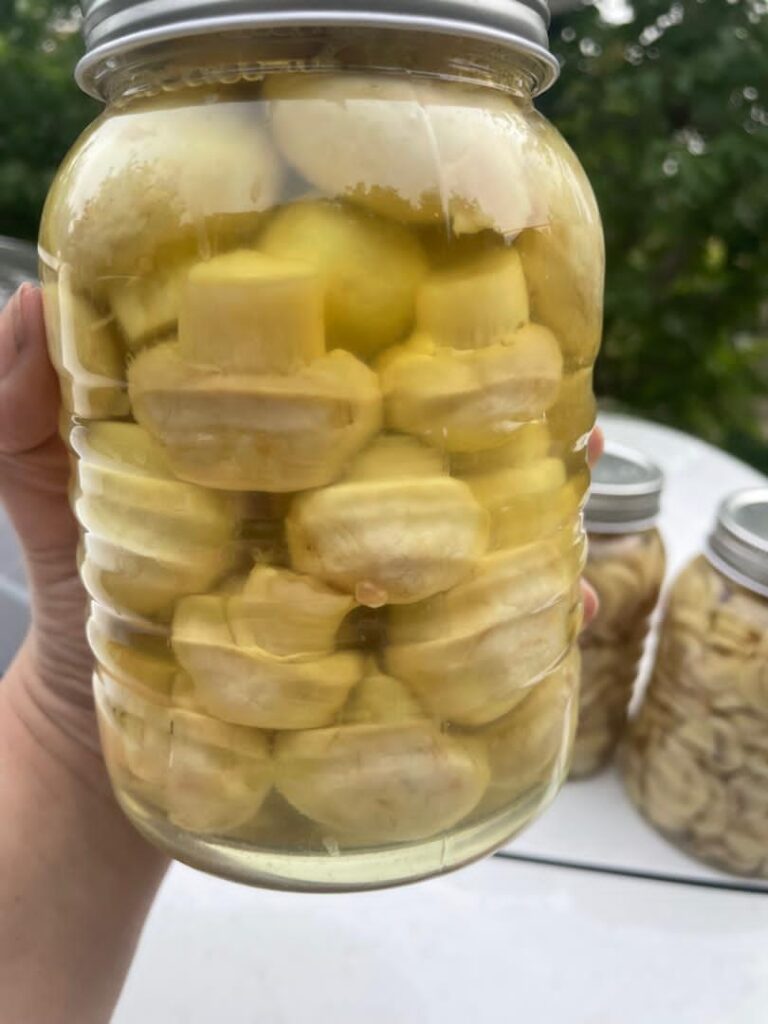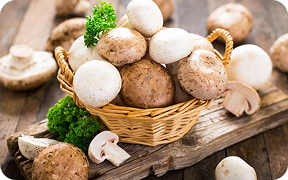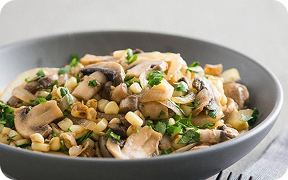Blanched Mushrooms: The Complete Guide
Table of contents
Introduction
Basic Concepts: What is Blanch?
Why do we blanch mushrooms?
Methods for blanching mushrooms
- Blanch with boiling water
- Steamed (蒸)
- Complementary and combined methods
Step-by-step steps for blanching mushrooms
- Initial preparation
- Blanching with boiling water
- Steam blanching
- Cooling and drying
- Storage and packaging
Important tips and tricks
- Choosing types of mushrooms
- Sizing and cutting
- Suitable temperature
- Blanching time
- Pollution and cleanliness
- Post-blanching storage
Uses of blanched mushrooms in cooking
- Use in salads
- Use in rice and stews
- Use in fast food and fast-food
- Use in mixed dishes and sauces
Introduction
Mushrooms are a popular ingredient in world cuisine, with their delicate texture, creamy flavor, and distinct aroma profile, making them a central or complementary ingredient in a variety of dishes. Blanching is a simple process that gives mushrooms a crisp, brighter color, and firmer texture, while also preserving certain compounds, such as antioxidants. This comprehensive article aims to provide detailed explanations, various methods for blanching mushrooms, practical tips, and practical applications in modern cooking.
Basic Concepts: What is Blanch?
Blanching is a process in which food is temporarily placed in hot water or steam and then quickly quenched in cold or colder water.
Purpose of blanching:
- Stopping the activity of enzymes that age tissue and color, which preserves color and texture
- Clean food surface and easier peeling of skin or surface layers
- Maintaining nutritional values and some antioxidant compounds
- Preparation for freezing or direct use in some cooking methods
Why do we blanch mushrooms?
- Maintaining the bright color and chewy texture of mushrooms after freezing or prolonged cooking
- Prevents color from turning gray or brown when cooked or mixed with other ingredients
- Reducing surface bacteria levels and increasing shelf life in the refrigerator or freezer
- Removing the bitterness of some mushrooms and preparing them for raw consumption in soups or salads
- Ease of peeling or superficial peeling in some species
Methods for blanching mushrooms
1-Blanch with boiling water
Tools and materials: Large pot, cold water, optional salt, spoon or spatula for removing mushrooms
Key process: Clean the mushrooms: Use a dry cloth or soft brush to remove dirt. Avoid washing with water for a long time as this will destroy their texture.
Slices : Cut the mushrooms into desired sizes. They are suitable for squares, slices, or halves.
Bring the water to a boil : In a large pot, bring the water to a boil with a pinch of salt (optional).
Blanch mushrooms: Briefly blanch mushrooms in boiling water. Typical time for chopped mushrooms is about 30–60 seconds; for larger or firmer-textured mushrooms, 1–2 minutes is fine.
Quick cooling: Remove the mushrooms from the water with a slotted spoon and transfer to a bowl or container with ice or cold water to stop the cooking process.
Drying: Pat the mushrooms dry with a paper towel or soft cloth to remove excess water.
Tips: Salt in water creates freshness and preserves texture.
Time, size and texture of the mushroom are important; avoid overcooking as the texture will become soft.
Steamed (蒸)2-
Tools and materials: Steamer (hard or simple), pot with lid, water in bottom, possibly steamer rack or basket
Preparation: Clean and cut the mushrooms. Make them the same size so that the steam spreads evenly.
Water mixture: Pour a small amount of water into the bottom of the steamer or pot to produce steam.
Placing the mushrooms: Arrange the mushrooms on a steamer basket or rack; do not let them submerge in water.
Steaming: Cover the container and steam for 1 to 3 minutes until the texture is slightly cooked.
Rapid cooling: Similar to the boiling water method, plunge the mushrooms into cold water or ice to stop the cooking process.
Drying: Dry with a paper towel or soft towel.
Tips :
Steaming helps preserve flavor and nutrients and usually gives mushrooms a softer texture than boiling.
Steaming time depends on the size, type of mushroom, and quantity.
3- Complementary and combined methods
Briefly blanch in boiling water and then plunge into ice: to quickly stop cooking and preserve color and texture
Blanching with other liquids such as dairy water or herbal extracts to create mild flavors: These methods are usually used for specific applications and are specific to the taste.
Two-stage blanching: first in boiling water, then in steam or in cold water, for precise texture and color adjustment
Drying and cold storage: After blanching, place the blanched mushrooms in freezer bags or sealed containers and freeze for long-term storage.
Step-by-step steps for blanching mushrooms
1- Initial preparation
Cleaning: Clean mushrooms with a dry cloth or soft brush to remove dirt and salts from their surface. Avoid prolonged rinsing with water, as excess water can soften the texture and reduce the flavor.
Cutting and slicing: Cut the mushrooms into appropriate sizes. If the mushrooms are small, you can use them whole. Cut large mushrooms into halves or quarters to ensure even cooking time.
Prepare the water: If using boiling water, bring a large pot of water to a boil and add salt if desired.
2-Blanching with boiling water:
Steps
Bring the water to a boil.
Put the prepared mushrooms in boiling water for the specified time.
Tiny or small mushrooms: 30 to 60 seconds
Medium mushrooms: 1 to 1.5 minutes
Large, firm mushrooms: 2 to 3 minutes
Remove the mushrooms from the water with a slotted spoon and transfer to a bowl of cold or ice water.
Place the mushrooms in cold water for a few minutes to cool them down and stop the cooking process.
Remove the mushrooms from the cold water and place them on a towel or paper towel to remove excess moisture.
If needed, you can pack and freeze the blanched mushrooms in separate freezer bags.
Tips:
Use very hot boiling water to cook the mushrooms well but still retain their texture. To maintain the white or light color of the mushrooms, add salt to the boiling water or use slightly salted water.
3-Blanching with steam
Steps:
Bring water to a boil in a pot or steamer.
Arrange the mushrooms neatly in the steamer basket, leaving some space between them for steam to circulate.
Steam for 1 to 3 minutes. The texture of the mushrooms depends on the type of mushroom and size.
Quickly transfer the mushrooms to cold or ice water to stop the cooking process.
Dry the mushrooms and store or consume as needed.
Tips:
With steam, color and texture are better preserved. Also, nutrients are lost relatively less than with boiling water.
Check the time carefully to avoid overcooking.
4- Cooling and drying
Rapid cooling helps preserve the color and texture of the mushrooms.
Methods:
Cold water or ice water: Place mushrooms in cold water for 1 to 2 minutes or until completely cooled.
If there is water, use a strainer or slotted spoon to remove excess water from the mushrooms.
5-Drying
Spread the mushrooms on a clean tray or towel and pat dry with a paper towel or soft cloth.
Avoid dust. Dried mushrooms retain the most texture and are best for freezing.
6-Preservation and packaging
Freezing:
Pack blanched mushrooms in freezer bags without excess air to prevent oxidation.
Typically, blanched mushrooms will keep in the freezer for up to 12 months, retaining their color and texture.
Refrigerate
Store blanched mushrooms in a covered container or resealable bag in the refrigerator for about 3 to 5 days.
Consumption
Blanched mushrooms reheat quickly in the oven or pan and can be used for everyday cooking.
Important tips and tricks
Choosing types of mushrooms
White mushroom (Agaricus bisporus): flexible, soft texture, and light color
Portobello and button mushrooms: good for surface blanching and texture creation
Oyster mushrooms and other varieties: have varying textures and cooking times; determine the appropriate time for each variety.
Wild or freshly harvested mushrooms: It is best to blanch them more carefully to preserve texture and color.
Sizing and cutting
Uniform sizes for mushrooms ensure even cooking.
Small or flaky mushrooms: allow for shorter time
Large mushrooms: Cut in half or quarters to cook evenly.
Suitable temperature
Boiling water with a temperature above 100°C is suitable for blanching.
High or low temperature steamer: Usually steam at 100 degrees or the appropriate temperature for steam
Using cold water to cool quickly stops the process and preserves the color.
Blanching time
Chopped or small mushrooms: 30 to 60 seconds in boiling water or 1 minute in steam
Medium to large mushrooms: 1 to 2 minutes in boiling water or 2 to 3 minutes in steam
To avoid cooking too quickly, it is best to keep the time short and finish with a quick chill.
Pollution and cleanliness
Mushrooms must be cleaned of soil and bacterial contamination.
Use clean and hygienic tools during the blanching process.
Avoid direct contact with contaminated water or dirty dishes.
Post-blanching storage
Packaging with air barriers to maintain quality
Freezing in the freezer with a mask or storing in special preparation capsules
For quick consumption, use blanched mushrooms with oil, salt and pepper or various sauces.
Uses of Blanched Mushrooms in Cooking 7-1 Use in Salads
Blanched mushrooms with a soft texture and light color are perfect for cold salads.
You can mix the mushrooms with olive oil, lemon, salt, and pepper.
Add to salads at the end to maintain texture and prevent softening after mixing with other ingredients.
Use in rice and stews
Blanched mushrooms are used as an additive in Iranian rice or stews such as gheemeh stew, mixed rice, and milk rice.
Last post
If you are looking for high quality blanched button mushrooms for consumption or packaging, Jolge Qalb Baghestan Company is serving its demanding customers. You can obtain and supply this product directly from the largest blanched (half-cooked) mushroom producer in the region.
To purchase directly from the factory without intermediaries, please contact the following numbers:
Factory: Shahriar Garden, Babasalman Town, Golzar Shohada Street, Baghdadi Alley.
Phone: 021-65285806
Mobile: 09228676481





